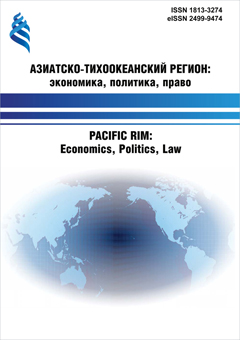Color revolutions in the post-Soviet space (2003–2022)
DOI:
https://doi.org/10.24866/1813-3274/2025-2/90-106Keywords:
anti-Russian policy, former Soviet Union states, colour revolutions, protest actions, foreign foundations, ‘rose revolution’, ‘Belarusian syndrome’, ‘gas revolution’, Euromaidan, algorithmAbstract
The article analyses successful and unsuccessful attempts at colour revolutions that took place in the post-Soviet space between 2003 and 2022. Based on the results, universal features are identified and a common algorithm is formulated. Common features of successful colour revolutions in the post-Soviet space include, in particular, the goal of depriving Russia of a real or potential ally, a contrived reason for discontent, usually related to violations of electoral law, the resulting demands of protesters, the use of methods for organising protests and the active use of information resources, recognisable symbols, the promotion of a symbolic leader as a ‘true fighter against dictatorship,’ support for the protest by international organisations, foreign states and foundations in various forms, as well as the consequences in the form of the dismantling of the former political regime and its incorporation into the sphere of influence of the collective West. The mechanism of the color revolutions itself is divided into three successive stages: canvassing stage – creating a negative image of the current government in the public consciousness and preparing the driving force for future protests, active stage – choice of a formal reason for rallies and their direct organization throughout the country, and the final stage – coming to power of the political elite that adhere to pro-Western guidelines. It is noted that over the past 5 years, not a single colour revolution in the former Soviet Union states has been successful. The authors conclude that in modern conditions it is possible to state the failure of the Western plan for colour revolutions.
Downloads
References
1. Павленко В. Б. 100 лет СССР: воспоминания о будущем? // Обозреватель. 2023. № 2 (397). С. 102–108. DOI: https://doi.org/10.48137/2074-2975_2023_2_102.
2. Об утверждении Концепции внешней политики Российской Федерации: указ Президента РФ от 31 марта 2023 г. № 229 // Собрание законодательства Российской Федерации. 2023. № 14. Ст. 2406.
3. Аксенов И. А. Санкционная политика США и стран Западной Европы в отношении России // Вестник университета. 2019. № 10. С. 147–151. DOI: https://doi.org/10.26425/1816-4277-2019-10-147-151.
4. Цветкова Н. А. Дискурс «цветных революций» // Постсоветские исследования. 2019. Т. 2, № 2. С. 940–950. EDN: ZAQKFV.
5. Наумов А. О. Зарубежная историография «цветных революций»: страновой аспект // Вестник Московского университета. Серия 21: Управление (государство и общество). 2021. № 3. С. 87–101. EDN: WBQQUR
6. Бахтуридзе З. З. Особенности развития внешнеполитической стратегии Грузии при президенте Э.А. Шеварнадзе (1995–2003 гг.) // Исторические, философские, политические и юридические науки, культурология и искусствоведение. Вопросы теории и практики. 2011. № 8-1(14). С. 27–31. EDN: OJQSQB.
7. Наумов А. О., Наумова А. Ю. Роль телеканала «Рустави-2» в подготовке и осуществлении «революции роз» в Грузии // Genesis: исторические исследования. 2023. № 12. С. 84–93. DOI: https://doi.org/10.25136/2409-868X.2023.12.39515.
8. Наумов А. О., Дубинкина К. А. Роль молодёжной организации «Кмара» в подготовке и осуществлении «революции роз» в Грузии // Дискурс-Пи. 2023. № 1.
С. 107–123. DOI: https://doi.org/10.17506/18179568_2023_20_1_107.
9. Силаев Н. Итоги августовской войны для Кавказа // Центральная Азия и Кавказ. 2009. № 3 (63). С. 7–19. EDN: PXCVHV.
10. Белова Н. Е. Технологии организации «цветных революций» на постсоветском пространстве // Приволжский научный вестник. 2014. № 12-2(40). С. 100–103. EDN: TGOJUL.
11. Когут В. Г., Нурышев Г. Н. Республика Беларусь в геополитическом измерении // Большая Евразия: развитие, безопасность, сотрудничество. М.: ИНИОН РАН, 2021. Вып. 4, ч. 1. С. 102–105.
12. Шагов А. Е. К вопросу о характере «цветных революций» на постсоветском пространстве // Современная научная мысль. 2022. № 5. С. 217–221. DOI: https://doi.org/10.24412/2308-264X-2022-5-217-221.
13. Грибин Н. П., Плетнев В. Я. «Белорусский синдром» в контексте обновлённой дорожной карты «цветных революций» // Власть. 2021. № 2. С. 9–21. DOI: https://doi.org/10.31171/vlast.v29i2.7988.
14. Циткилов П. Я. Общественная дестабилизация в Беларуси конца лета – осени 2020 г., её внешнеполитические факторы // Социально-гуманитарные знания. 2021. № 1. С. 18–43. EDN: OGDJWE.
15. Соколов А. В., Курбанова А. А. Массовые движения в современной России (на примере движения в поддержку А. Навального) // Вестник Томского государственного университета. Философия. Социология. Политология. 2019. № 52. С. 231–245. DOI: https://doi.org/10.17223/1998863X/52/21.
16. Кривенко Г. И. Январские протесты 2022 г. в Казахстане // История и современность. 2023. № 1. С. 107–123. DOI: https://doi.org/10.30884/iis/2023.01.05.
17. Чаевич А. В. «Цветная революция» в Казахстане как очередная угроза национальной безопасности России // Власть. 2022. № 1. С. 110–115. DOI: https://doi.org/10.31171/vlast.v30i1.8792.
Downloads
Published
Issue
Section
License
Copyright (c) 2025 Александр Альбертович Казаков, Артём Юрьевич Коновалов

This work is licensed under a Creative Commons Attribution-NonCommercial-NoDerivatives 4.0 International License.


